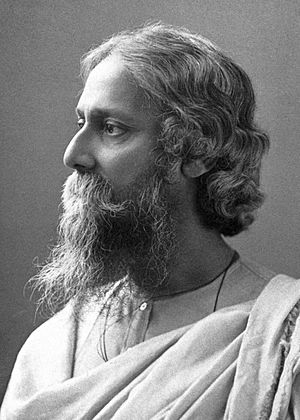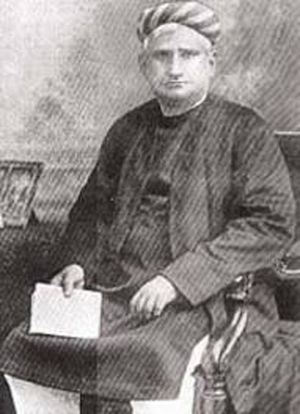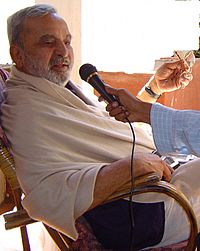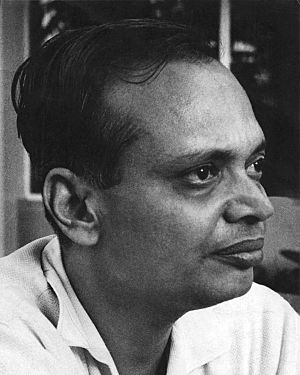Indian literature facts for kids
Indian literature is all the amazing writing created in the Indian subcontinent (the area that includes modern-day India and its neighbors) up until 1947. After that, it refers to literature from the Republic of India. India has 22 official languages, and each has its own special stories and poems!
At first, Indian stories and poems were passed down by speaking them, not writing them. The oldest Sanskrit literature comes from the Rig Veda, a collection of ancient hymns from around 1500–1200 BCE. Later, famous Sanskrit epics like the Ramayana and Mahabharata were written down. Other important early writings include the Pāli Canon and Tamil Sangam literature.
During the medieval period, new literature appeared in languages like Kannada and Telugu. Later, writings in Marathi, Gujarati, Bengali, Assamese, Odia, and Maithili also became popular. Over time, literature in different Hindi dialects, Persian, and Urdu also grew.
In 1913, the Bengali poet Rabindranath Tagore became India's first Nobel Prize winner for literature. Today, India has two main literary awards: the Sahitya Akademi Fellowship and the Jnanpith Award.
Contents
- Ancient Indian Languages and Their Stories
- Literature in Modern Indian Languages
- Assamese Literature: From Hymns to Modern Tales
- Bengali Literature: Nobel Laureates and National Songs
- English Literature: A New Voice
- Hindi Literature: From Devotion to Modern Stories
- Gujarati Literature: A Long History
- Kannada Literature: Ancient Roots and Modern Success
- Malayalam Literature: From Songs to Novels
- Maithili Literature: Vidyapati's Legacy
- Meitei Literature: Surviving Through Time
- Marathi Literature: Saints, Reformers, and Modern Writers
- Odia Literature: Ancient and Resilient
- Punjabi Literature: From Ancient Texts to Modern Stories
- Tamil Literature: A Rich and Long Tradition
- Telugu Literature: Epic Tales and Modern Movements
- Urdu Literature: A Blend of Cultures
- Literature in Foreign Languages in India
- Awards for Indian Literature
- See also
Ancient Indian Languages and Their Stories
Vedic Literature: Ancient Wisdom
Some of the earliest writings in Vedic Sanskrit include the main Vedas and Upanishads. These texts contain ancient wisdom and religious teachings. The Sulba Sutras are also important early texts that talk about geometry.
Epic Sanskrit: Tales of Heroes
The two greatest Sanskrit epics are the Mahabharata by Ved Vyasa and the Ramayana by Valmiki. These long poems tell exciting stories of heroes, gods, and battles. They are still very important in Indian culture today.
Classical Sanskrit: Plays and Grammar
Kālidāsa was a very famous poet and playwright. He wrote the epic Raghuvamsha (Dynasty of Raghu). Other important works include Pāṇini's Ashtadhyayi, which set the rules for Classical Sanskrit grammar. The Laws of Manu is another well-known text in Hinduism.
Kālidāsa's most famous play is Recognition of Shakuntala. His poem Meghaduuta is also very popular. Other famous plays include Mricchakatika by Shudraka and Svapna Vasavadattam by Bhasa.
Prakrit Literature: Everyday Languages
Prakrit languages were simpler forms of Sanskrit, often spoken by common people. Important Prakrit languages included Jain Prakrit, Pali, Gāndhārī, Maharashtri, and Shauraseni.
One of the oldest Prakrit works is Hāla's Gāhā Sattasaī, a collection of poems from the 3rd to 5th centuries CE. Even famous writers like Kālidāsa used Maharashtri in some of their plays. Many Jain religious works were also written in Maharashtri.
Pali Literature: Buddhist Teachings
The Theravada Buddhist scriptures, called the Tipitaka, are mostly written in the Pali language. These texts include Buddhist discourses, poetry, and stories like the Jataka tales. Later Pali works, like the Milindapanha, were also written in India.
Tamil Sangam Literature: Ancient Tamil Poems
Sangam literature is ancient Tamil literature from around 300 BCE to 300 CE. This collection has 2381 poems written by 473 poets. Most of these poems are from the Third Sangam period.
Sangam literature talks about human relationships and emotions. It covers topics like love, war, how to govern, trade, and sadness. Great Tamil scholars like Thiruvalluvar, who wrote about ethics and life, lived during this time.
Literature in Modern Indian Languages
Assamese Literature: From Hymns to Modern Tales
The Buddhist Charyapadas, written between the 8th and 12th centuries, are thought to be the earliest examples of Assamese literature. These songs are similar to early Oriya and Bengali writings.
Later, writers like Hema Saraswati and Madhav Kandali (who translated the Ramayana into Assamese) became important. The most famous Assamese writer is Srimanta Sankardev. He introduced drama, poetry, classical dance (Satriya), and music (Borgeet) to Assamese culture. His followers, like Madhabdev and Damodardev, also added a lot to Assamese literature.
Many modern Assamese writers have continued to enrich the language, including Lakshminath Bezbaruah, Nalini Bala Devi, and Mamoni Raisom Goswami.
Bengali Literature: Nobel Laureates and National Songs


The first Bengali writings are the Charyapada, Buddhist hymns from the 8th century. These are the oldest known written forms of Bengali.
The most famous Bengali writer is Rabindranath Tagore, who won the Nobel Prize for Literature in 1913 for his work "Gitanjali." He wrote the national anthems for both India ("Jana Gana Mana") and Bangladesh ("Amar Sonar Bangla"). He was the first Asian to win a Nobel Prize. Tagore wrote many poems, songs, essays, novels, and plays.
Kazi Nazrul Islam is another very popular and important Bengali writer. Other famous Indian Bengali writers include Sharat Chandra Chattopadhyay and Bankim Chandra Chattopadhyay, who wrote India's National Song 'Vande Mataram'.
Bengali is the second most spoken language in India. Many famous Indian literary works, poems, and songs from the 19th and 20th centuries are in Bengali.
English Literature: A New Voice
In the 20th century, many Indian writers started writing in English, a language they learned from the British. This led to a unique style called Indian English.
Rabindranath Tagore wrote some of his works in English and also translated his Bengali writings into English. Famous modern Indian English novelists include Chetan Bhagat, Manjiri Prabhu, and Ashok Banker. Other major writers who get inspiration from Indian themes are R. K. Narayan, Vikram Seth, Salman Rushdie, Arundhati Roy, and Jhumpa Lahiri.
Many Indian poets also write in English. Early poets include Derozio and Sarojini Naidu. Later, poets like Dom Moraes and Nissim Ezekiel became very important.
Several Indian writers writing in English have won the prestigious Booker Prize, including Salman Rushdie, Arundhati Roy, Kiran Desai, and Arvind Adiga.
Hindi Literature: From Devotion to Modern Stories
Hindi literature began with religious poetry in medieval times, using dialects like Avadhi and Brij. Famous poets from this period include Kabir and Tulsidas. Later, the Dehlavi dialect became more important than Sanskrit.
Chandrakanta by Devaki Nandan Khatri is considered the first Hindi prose work. Munshi Premchand was a very famous Hindi novelist. Important poets include Suryakant Tripathi 'Nirala', Jaishankar Prasad, and Mahadevi Varma.
Gujarati Literature: A Long History
Gujarati literature has a history going back to 1000 AD. Well-known Gujarati writers include Narsinh Mehta, Mirabai, Gandhi, and Umashankar Joshi.
Several Gujarati writers, like Umashankar Joshi and Pannalal Patel, have won the Jnanpith Award, which is India's highest literary honor.
Kannada Literature: Ancient Roots and Modern Success

The oldest Kannada writing is the Halmidi inscription from 450 CE. Kavirajamarga (850 CE) by King Nripatunga Amoghavarsha I is the earliest existing literary work. It talks about literary criticism and poetry.
Famous poets like Pampa wrote epics such as "Vikramarjuna Vijaya" and "Adipurana". The Vachana Sahitya tradition from the 12th century is unique. These were short comments on society and religion, written by people from all walks of life, including Basavanna and Akka Mahadevi.
Modern Kannada literature has been very successful. Kannada works have won eight Jnanpith awards, which is the highest number for any Indian language. They have also received forty-seven Sahitya Academy awards.
Malayalam Literature: From Songs to Novels
For a long time, Malayalam literature mostly consisted of songs. Ramacharitham by Cheeramakavi is one of the oldest Malayalam books. Thunchaththu Ramanujan Ezhuthachan (17th century) is called the Father of the Malayalam language because of his influence on the language and his popular poems.
In the 20th century, Malayalam literature grew rapidly and became a fully developed part of Indian literature, with many different types of writing.
Maithili Literature: Vidyapati's Legacy
Vidyapati (1350–1450) is the most famous literary figure in Maithili. He wrote poems in the language of the common people, even though Sanskrit was the official language. After Vidyapati, using Maithili in literature became more common.
The Maithili script, also known as Mithilakshara or Tirhuta, is very old.
Meitei Literature: Surviving Through Time
Meitei literature is written in the Meitei language (Manipuri). Its history goes back thousands of years. Even after a huge event where many Meitei scriptures were burned (Puya Meithaba), Meitei literature survived. Most early works were poetry or prose. M. K. Binodini Devi is a famous Meitei writer from the 20th century.
Marathi Literature: Saints, Reformers, and Modern Writers
Marathi literature began with saint-poets like Dnyaneshwar, Tukaram, and Eknath. They wrote religious texts and poems. Dnyaneshwar wrote a long commentary on the Bhagavad Gita called Dnyaneshwari.
In the 18th century, writers like Moropanta produced important works. The historical section of old Marathi literature included Bakhars (prose) and Povadas (poetry) about the Maratha kingdom.
Modern Marathi Literature (after 1800)
The late 19th century brought modern Marathi literature, influenced by English education. It was a time of social reform. The first Marathi newspaper started in 1835. Writers like Mahatma Jyotiba Phule and Lokhitwadi wrote about social issues.
Marathi drama also became very popular. The first play was V.A. Bhave's Sita Swayamvar in 1843. Later, playwrights like Krishnaji Prabhakar Khadilkar and Prahlad Keshav Atre wrote important plays. Modern Marathi poetry began with Mahatma Jyotiba Phule. Later poets like Keshavsuta were influenced by English Romantic poetry. Sane Guruji wrote many children's books, including Shyamchi Aai (Shyam's Mother).
Odia Literature: Ancient and Resilient
Odia literature started with the charyapadas in the 8th century AD. Sarala Das (14th century) is known as the Vyasa of Odisha because he translated the Mahabharata into Odia. Jagannatha Das translated the Srimad Bhagavatam, which helped standardize the written form of the language. Odia has a strong tradition of devotional poetry.
In the 19th century, Fakir Mohan Senapati and Kabibar Radhanath Ray were important figures. In the 20th century, writers like Gopinath Mohanty and Sitakant Mahapatra continued to enrich Odia literature. In 2014, the Government of India recognized Odia as a classical language.
Punjabi Literature: From Ancient Texts to Modern Stories
The history of Punjabi literature begins with the ancient texts of the Rig-Veda. The Punjabi literary tradition is often said to start with Fariduddin Ganjshakar (1173–1266), whose spiritual poems were collected in the Adi Granth.
The Janamsakhis, stories about the life of Guru Nanak, are early examples of Punjabi prose. Sufi poetry became popular with poets like Shah Hussain and Bulleh Shah. Punjabi Sufi poets often wrote in the Kafi style.
Punjabi Qissa, a type of romantic tragedy, was also popular. Famous Qissas include Heer Ranjha by Waris Shah. With British education, modern literary styles like novels and free verse came to Punjabi literature.
Tamil Literature: A Rich and Long Tradition
Tamil literature has a very long history, going back more than 2500 years to the Sangam period. Tolkaappiyam (3rd century BC) is the oldest Tamil work available. Early Sangam poetry was about everyday life, but later works became more religious.
Tirukkural is a great example of a work about human behavior and morals. Religious movements led to many writings by Saivite and Vaishnavite authors. Jain, Buddhist, Muslim, and European writers also contributed to Tamil literature.
In the late 19th century, Tamil literature saw a revival. Writers started using simpler styles so more people could enjoy their works. Nationalist poets used poetry to inspire people. Short stories and novels also began to appear. The popularity of Tamil Cinema has also helped modern Tamil poets.
Telugu Literature: Epic Tales and Modern Movements
Telugu has many speakers and a rich literary tradition. The earliest written literature dates back to the 7th century. The epic tradition began with Nannayya (10th or 11th century), known as Telugu's Aadikavi (first poet).
Vemana (14th century) was a prince who wrote poems in the common language. He questioned old values and religious practices, making him a unique poet for the people.
Viswanadha Satyanarayana was the first to receive the Jnanpith Award for Telugu. Srirangam Srinivasarao or Sri Sri (1910–1983) was a popular 20th-century poet who brought Telugu literature to the common person.
Literary Movements in Telugu
Telugu literature has been shaped by many movements. The Veera Shaiva movement led to dwipada kavitvam (couplets). The Bhakti movement brought works by Annamayya and Tyagaraja.
Modern movements include the Romantic Movement, Progressive Writers Movement, and others like Streevada Kavitvam (feminist poetry) and Dalita Kavitvam (Dalit poetry).
Kandukuri Veeresalingam is considered the father of Modern Telugu fiction. Many writers like Gurajada Appa Rao and Unnava Laxminarayana have had a big impact on Telugu literature.
Urdu Literature: A Blend of Cultures
Urdu poetry is a great example of how different languages and cultures can mix. It combines Arab and Persian words with Hindi, creating beautiful ghazal poetry. Urdu became the court language of the Mughals.
Famous Urdu poets include Mir, Ghalib, Iqbal, and Faiz. The poetry of Muhammad Iqbal inspired a sense of freedom among Muslims in India.
Urdu fiction has also grown a lot. Umrao Jaan Ada by Mirza Hadi Ruswa is an important early Urdu novel. Munshi Premchand is seen as the father of modern Urdu fiction with his novel Godan. Later writers like Manto and Krishn Chander also wrote acclaimed short stories.
Literature in Foreign Languages in India
Indian Persian Literature: A Language of Courts
During the early Muslim period, Persian became the official language in northern India. It was used by educated people and the government. Many Indians became famous Persian poets, like Amir Khusro and, later, Muhammad Iqbal. Much of the old Sanskrit literature was also translated into Persian.
Persian was the court language of the Mughals for a while, before Urdu took its place. Even after Urdu spread, Persian remained important until the early years of British rule. In 1837, the British decided to use English instead of Persian for official purposes. This led to the decline of Persian as a main government language in India. However, many modern Indian languages, especially Urdu and Hindi, still show a lot of Persian influence.
Awards for Indian Literature
- Sahitya Akademi Fellowship
- Jnanpith Award
- Sahitya Akademi Award
- Vyas Samman
- Saraswati Samman
See also
 In Spanish: Literatura de la India para niños
In Spanish: Literatura de la India para niños
- Indian epic poetry
- List of ancient Indian writers
- Indian Literature (journal)
- Indian poetry
- Literature from North East India
- Stephanian School of Literature



